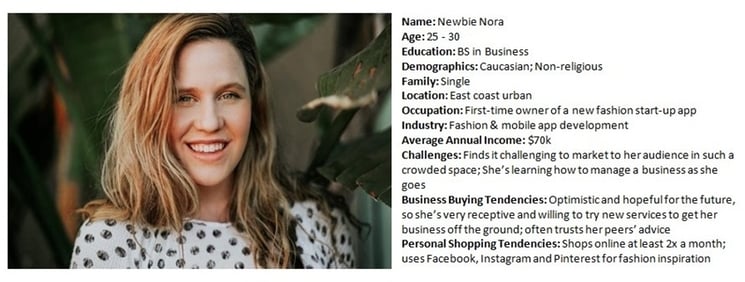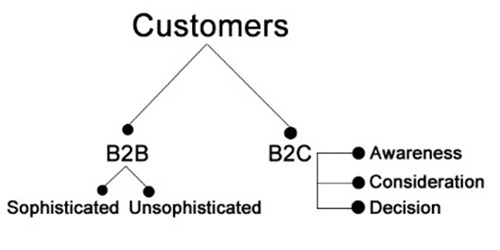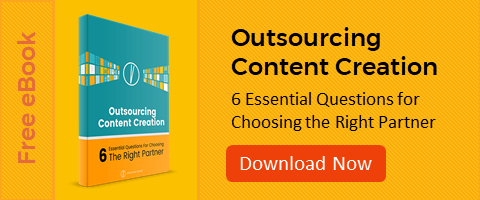Now that you know what buyer personas are and how they can fit into your company’s marketing strategy, it’s time to put this research into action. This blog post shows you what a complete buyer persona might look like, what information it could include and how you might be able to leverage the data when you buy blog content, articles and more.
Assuming that you’ve already distributed the questionnaires, interviewed real consumers and reviewed market insights, you’re ready to go ahead and organize the information into a digestible format. Below is an example of a fictional buyer persona, which you can use to model your own after. However, there are many different formats that work just as well, from spreadsheets to graphs. An in-house designer can easily draft one up, but there are also comprehensive buyer persona templates available online, such as HubSpot’s and Demand Metric’s.
Our Example Buyer Persona

As you can see, by using short statements and clearly defined headers – plus a picture to help visualize who the consumer is – you’ll be able to get a firm grasp on who he or she is. Be sure to include every piece of information you can about this persona, because the more knowledge you can gather, the better. No matter how trivial something may seem, it all comes together to create the bigger picture that ultimately informs their buying decisions.
Drawing The Connections
As you put together your buyer persona, it’s a good idea to break up the information into subcategories. That way, it’s easy to see if you’re missing anything. Some key info to look for includes the basics – like age, gender, religion and ethnicity. Other subcategories include:
- Occupation: company, job title, job role, industry and career track
- Personal background and history: marital status, children, average household income
- Education
- Shopping habits
- Goals
- Challenges
Not only do you want to know their present tendencies and stats, but also their past and their projected future. Their history especially comes into play more than you might realize. A B2B customer that had a poor experience with their last service is probably going to be more cautious about moving forward with yours.
Similarly, just because a B2C customer has a high annual income, doesn’t mean they’re willing to spend a lot on your product. Maybe they were raised in a low-income household and, as a result, became more of a conservative shopper. Or maybe they have multiple children that they need to allocate their expenses to. The more you know, the better.
Aside from that general info, you should also tailor these questions to meet your specific industry. For example, if your company sells fitness equipment, you’ll also want to know how frequently they exercise and where they exercise. It’s just a matter of taking this framework and adapting it to your own needs. Answer the questions that are important to you and your business.
Creating Multiple Buyer Personas
If your company sells a variety of different products or services, has multiple locations across the country or globe or has a diverse consumer base, you’ll probably need to create more than one buyer persona. When you have vastly different types of customers, a single persona can’t cover all of their habits and motivations.
Since we know that consumers respond better to personalized content, segmenting them into as many logical groups as possible will be more beneficial for both of you. With more buyer personas readily available, you’ll be better able to personalize advertisements, blog posts and e-mails. Why is this so important? Because as Statista reports, the open rate for e-mails with a personalized message rises to 17.6%, while those without a personalized message only delivered an 11.4% open rate.
So just how should you segment your customers, and how many buyer personas do you really need? This answer is going to vary from company to company. But, in general, you want to create buyer personas that represent a large portion of your consumer base. Isolate groups with the highest potential for lead generation and go from there.

Here are some ways you can divide up your personas:
- B2B vs. B2C
- Sophisticated vs. Unsophisticated; Experienced vs. Inexperienced
- Industry/Job Title
- Education Level
- Gender
- Age
- Location
- Lifecycle Stage
If you’re a retailer, it might make sense to segment by gender and age. But if you’re a B2B service, separating between job title and experience might be a better choice. Dividing by location is also key. While Person A and Person B might be similar as far as their buyer personas go, where they live and work can greatly affect their need for your product.
For example, a car dealership in the Northeast can use snow and harsh weather to entice customers into purchasing 4WD vehicles and SUVs, whereas a dealership on the West Coast likely won’t be as successful.
Another aspect to consider is the customer’s demeanor. Are they friendly and receptive to new ideas, or are they difficult communicators who like to stick to their habits? Determining this ahead of time and creating a buyer persona for traits like this can come in handy, especially when the sales team is getting ready to pitch.
And finally, when crafting your buyer persona(s), always account for lifecycle. Newbie Nora in the awareness stage of the buyer’s journey is going to be different from Newbie Nora in the decision stage. She’ll require different marketing tactics, education and nurturing in order to get her to the next phase of the lifecycle.
Leveraging the Buyer Persona
Once your buyer persona is complete, you can move forward and implement marketing campaigns and strategies with confidence. Here are just a few ways that you can use information from the persona to your advantage:
- Word choice. Based on the persona’s age, education and occupation, would they prefer a formal or casual tone? You can also incorporate lingo specific to their industry or lifestyle.
- Images. Use images that look like your buyer persona, so that the customer can envision themselves using your product or service.
- Meet them where they shop. Do your customers tend to shop online or in store? Does social media influence their buying decisions? Determine the channel(s) and meet them there.
- Co-marketing. Collaborate with other brands and/or celebrities that your customers will respond to.
- Identify objections. If you can determine why your persona, like Newbie Nora, might object to your product, then you’ll be able to craft a counterclaim ahead of time.
But remember, even when your buyer persona is done and ready to go, it’s never actually finished. Trends, technologies and people are constantly evolving, and so your personas and strategies must evolve in tandem. Just keep analyzing what works and what doesn’t in order to keep attracting the right customers.
Ready to buy blog content now that you have a firm grasp on buyer personas?
Make sure you choose the right content provider for your needs. Download our free ebook to learn more about hiring content creators.






